zavier simpson abdul jabbar
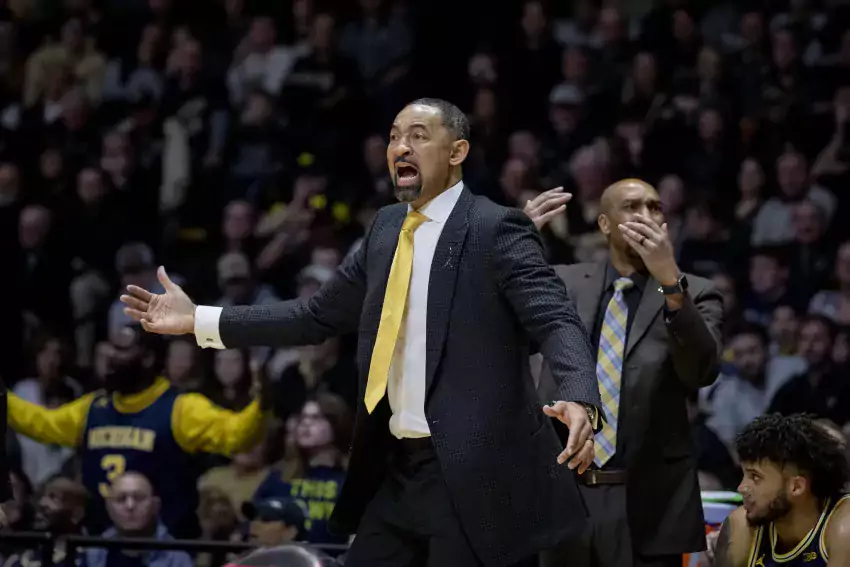
Let's dive back in to more of your questions, starting with what makes for a successful coach.
Hi Ace,
Curious on your thoughts on what the most important aspects to being a great college coach are (e.g. 40% recruiting/roster management, 30% team management, 20% PR/face of program, 10% scheme/Xs-and-Os, etc), and how you'd grade Howard's first season along those lines, as well as a prognosis going forward.
Best,
Mike
I'll preface with this: there's a lot more than one way to be a highly successful college coach. Recruiting at a high level can cover for shortcomings as a strategist. A strong player development program can make up for recruiting lesser talent than your peers. John Beilein and Larry Brown have (officially) made the same number of Final Fours. Same goes for Bill Self and Jay Wright. These coaches aren't similar in on- or off-court approach but they've fit at their respective schools, which is arguably the most important factor.
If I had to break it down into categories, they'd be: fit with school/administration, recruiting/image, roster management, player development, scheme, and game management. While an elite college coach doesn't have to be great at every one of these factors, they usually check off most of the boxes.
It's early yet to be able to judge Juwan Howard on some of these. A quick stab at grades:
Fit with school/administration: A. I'm assuming the readers of this post are familiar with Juwan Howard, former All-American at Michigan, basketball lifer, and universally regarded good dude. It's hard to overstate how fortunate the program was that such a tight fit was available despite the late timing of John Beilein's departure.
Recruiting/image: A. Howard is the face of the program, his first recruiting class ranks fourth in the country, and he could still add a second five-star to that group. This moves up to an A+ if Josh Christopher commits—it'd be difficult to imagine a better start after Howard had to hit the ground running with a 2020 class that needed more commits than usual.
Roster management: Incomplete. We'll learn more about Howard's ability to juggle a roster this offseason. He appears prepared for unexpected attrition with Michigan's pursuit of multiple grad transfer point guards even though the team is full for the moment after scratching Austin Davis and Adrien Nunez off the potential attrition list.
Beilein learned the hard way that great programs lose players at a steady rate to both the NBA and programs where even established rotation players can find more playing time; it took him a while to adjust and he still got caught off-guard by last year's early entry decisions by Jordan Poole and Iggy Brazdeikis. Howard seems to know how the game is played and his experience as both a former elite player and the father of high-level prospects should serve him well.
Player development: Incomplete. The unexpected breakout of Austin Davis indicates Howard at least should be good at getting the most out of his big men. That said, it's way too early to put a grade on his player development. This is something to revisit a year or three down the road.
Scheme: B+. I really like the framework. Howard didn't stand pat with John Beilein's offense despite having his pick-and-roll duo as seniors, instead building around the ball screen offense with plenty of NBA sets and added wrinkles. The defensive philosophy was also clear: play man defense with the occasional zone changeup (almost always after a timeout), use drop pick-and-roll coverage when possible, run shooters off the arc, and force players to beat you one-on-one.
I need to see more to move the grade any higher, especially since he could build so much off the Simpson/Teske pick-and-roll—we'll get a clearer view of how Howard wants to operate as he molds the roster to his preference instead of working with another coach's players.
Game management: B-. The area I most want to see improvement. Howard made some strange lineup decisions during the season that were usually borne of his strong adherence to the hated autobench policy. His best schematic adjustments often came either between games against the same opponent (see: hedging Cassius Winston and leaving Xavier Tillman to shoot in the second MSU game) or too late in the game to alter the outcome (see: playing Brandon Johns at center against Wisconsin).
I wouldn't say Howard was bad at game management by any stretch. He had to work within some serious limitations when Franz Wagner and Isaiah Livers were absent for significant stretches of time. He utilized timeouts well on both ends, drawing up effective plays and using that zone changeup to flummox offenses running a set to beat man. I would've loved to see him in a postseason tournament setting this year. Alas.
[Hit THE JUMP for what I'm missing most about the tournament, what next year's offense could look like, and more.]
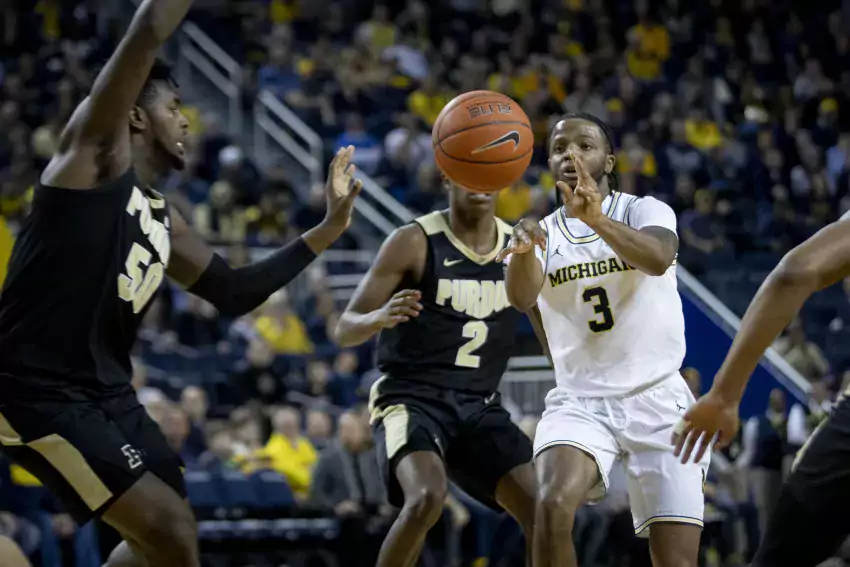
Previously: Part One, Part Two. If you're looking for the Rutgers preview it's here.
You're definitely going to want to at least read part two of this series, which explains the stats I'm using below and details the 2009-14 seasons, before moving on to the rest of this post. Ideally, you'll read part one, as well.
Now that you're caught up, let's get to it.
2014-15: Bad Wheels
Team Stats: 27.7% pick-and-rolls + passes (#36 in country), 0.911 points per play (#62)
The Ballhandlers:
| P&R Plays (Own Offense) | PPP on Own Offense (%ile) | P&R Plays (Passes) | PPP on Passes (%ile) | Total P&R Plays | Overall P&R PPP. (%ile) | Keep % | |
|---|---|---|---|---|---|---|---|
| Spike Albrecht | 65 | 0.815 (70%) | 98 | 1.276 (92%) | 178 | 1.092 (93%) | 36.5% |
| Caris LeVert | 87 | 0.644 (35%) | 58 | 0.862 (34%) | 145 | 0.731 (28%) | 60.0% |
| Derrick Walton | 52 | 0.635 (33%) | 61 | 0.967 (54%) | 113 | 0.814 (47%) | 46.0% |
| Zak Irvin | 60 | 0.783 (63%) | 43 | 1.395 (96%) | 103 | 1.039 (90%) | 58.3% |
| MAAR | 39 | 0.872 (79%) | 19 | 1.737 (100%) | 58 | 1.155 (96%) | 67.2% |
The Screeners:
| Pop Plays (%) | Pop PPP (%ile) | Roll Plays | Roll PPP (%ile) | Slip Plays (%) | Slip PPP (%ile) | Overall Plays | Overall PPP (%ile) | |
|---|---|---|---|---|---|---|---|---|
| Max Bielfeldt | 12 (36.4%) | 1.167 (88%) | 19 (57.6%) | 1.000 (30%) | 2 (6.1%) | 2.000 (—) | 33 | 1.121 (76%) |
| Ricky Doyle | 1 (3.6%) | 2.000 (—) | 26 (92.9%) | 1.308 (74%) | 1 (3.6%) | 0.000 (—) | 28 | 1.286 (90%) |
| Zak Irvin | 9 (69.2%) | 1.222 (—) | — | — | 4 (30.8%) | 2.000 (—) | 13 | 1.462 (96%) |
| Mark Donnal | 1 (10%) | 3.000 (—) | 9 (90%) | 1.556 (—) | — | — | 10 | 1.700 (99%) |
I almost didn't include this season or the next because of Michigan's injury issues, then decided it was useful to see what happens when a team's two best perimeter players get hurt in the same season.
While neither Caris LeVert nor Derrick Walton were producing particularly well in the pick-and-roll before their respective foot injuries, we saw later that these injuries delayed breakouts into effective players—Walton, in particular, eventually became a great P&R ballhandler.
The players that remained were effective but one-dimensional. Spike Albrecht drove to pass. Zak Irvin and Muhammad-Ali Abdur-Rahkman hunted shots off of screens. Irvin, defying reputation, struck the best balance between shooting and passing, and he was a very effective passer. Only MAAR was above-average at generating his own offense off of screens, though.
Derrick Walton's foot injury stunted a developing rapport with Ricky Doyle
Michigan was also working with a limited group of finishers. Ricky Doyle was the best roll man but was a roll man only. Max Bielfedlt(!) ended up with the most plays among screeners even though he was a 30th-percentile finisher on the roll; he salvaged decent efficiency with some pick-and-pop jumpers. If Zak Irvin was setting a screen, it was to pop or slip for a jump shot.
This marks the first season since 2008-09 that Michigan's pick-and-roll usage went down; they also slipped 40 spots in the efficiency rankings. This team was going to drop off with the departures of Nik Stauskas, Glenn Robinson III, and Jordan Morgan, then injuries made matters worse. Even if LeVert and Walton weren't high-level P&R ballhandlers at this point, their spot-up shooting could've helped.
Even with all that, Michigan's pick-and-roll offense ranked in the 83rd percentile by points per play. They weren't elite; they were still good. They just couldn't build the offense around it to the extent they had the previous year.
2015-16: Bad Wheels 2
Team Stats: 30.5% pick-and-rolls + passes (#22 in country), 0.923 points per play (#80)
The Ballhandlers:
| P&R Plays (Own Offense) | PPP on Own Offense (%ile) | P&R Plays (Passes) | PPP on Passes (%ile) | Total P&R Plays | Overall P&R PPP. (%ile) | Keep % | |
|---|---|---|---|---|---|---|---|
| Derrick Walton | 128 | 0.711 (44%) | 120 | 1.000 (59%) | 248 | 0.851 (51%) | 51.6% |
| Zak Irvin | 149 | 0.826 (68%) | 98 | 1.306 (93%) | 247 | 1.016 (86%) | 60.3% |
| Caris LeVert | 57 | 0.877 (77%) | 62 | 0.855 (32%) | 119 | 0.866 (54%) | 47.9% |
| MAAR | 67 | 0.910 (82%) | 41 | 0.805 (24%) | 108 | 0.870 (55%) | 62.0% |
| Duncan Robinson | 19 | 0.632 (29%) | 17 | 0.647 (9%) | 36 | 0.639 (14%) | 52.8% |
The Screeners:
| Pop Plays (%) | Pop PPP (%ile) | Roll Plays | Roll PPP (%ile) | Slip Plays (%) | Slip PPP (%ile) | Overall Plays | Overall PPP (%ile) | |
|---|---|---|---|---|---|---|---|---|
| Mark Donnal | 12 (21.8%) | 0.500 (12%) | 40 (72.7%) | 1.250 (60%) | 3 (5.5%) | 0.667 (—) | 55 | 1.055 (60%) |
| Ricky Doyle | 1 (2.9%) | 2.000 (—) | 30 (88.2%) | 1.200 (54%) | 3 (8.8%) | 0.333 (—) | 34 | 1.147 (73%) |
| Moe Wagner | 3 (15.8%) | 1.667 (—) | 16 (84.2%) | 1.375 (77%) | — | — | 19 | 1.421 (95%) |
| DJ Wilson | 9 (64.3%) | 0.556 (—) | 4 (28.6%) | 1.500 (—) | 1 (7.1%) | 0.000 (—) | 14 | 0.786 (24%) |
| Zak Irvin | 9 (81.8%) | 1.000 (—) | — | — | 2 (18.2%) | 0.000 (—) | 11 | 0.818 (27%) |
An unfortunate repeat, as Walton's previous foot injury sapped his ability to finish at the rim and LeVert—who'd improved considerably as a scorer off the high screen—again lost most of the season to a bad wheel.
Beilein increased the volume past where it had been in 2013-14 and the team's PPP slightly increased, though they came out worse compared to the rest of the country. Irvin was easily the team's best P&R ballhandler, continuing to pass at a high level while making enough pull-up jumpers to be relatively effective as a scorer.
some of those jumpers were rather important
MAAR pulled off a tough feat, averaging more PPP using his own offense than when he passed; that's very much a good news/bad news situation.
The roll men remained limited. This was the year Ricky Doyle seemingly lost the ability to catch and finish, so Mark Donnal ended up as the primary screener. Neither graded out particularly well. The center who did: enigmatic freshman Moe Wagner, who scored well as a roll man and flashed the ability to pop out and hit jumpers.
[Hit THE JUMP for Michigan exploring that a bit more.]

Juwan Howard learned from his first encounter with Wisconsin, just not quite fast enough for Michigan to pull off a double-digit comeback as the Wolverines fell, 81-74, in their lone regular-season meeting with the Badgers.
Michigan went into the game shorthanded; Eli Brooks sat out with the broken nose suffered in Saturday's win at Purdue, Wisconsin held a ten-point halftime lead as point guard D'Mitrik Trice (13 first-half points on 5/7 FG) and backup center Micah Potter (11, 4/6) exploited Michigan's big men with their pick-and-pop offense. On the other end, the Badgers stuck tight to shooters, limiting M to three attempts from beyond the arc. That forced Zavier Simpson to be the primary scoring threat; he entered the break with 18 points and no assists—no other Wolverine had more than five points. Adrien Nunez played a stint that went as you'd expect.
 you can see Howard thinking "never again" [Campredon]
you can see Howard thinking "never again" [Campredon]
The approach to Wisconsin's swing offense, no-help defense, and lineups all had to change. To Howard's great credit, he made the proper adjustments. Michigan used more off-ball motion, leading to a Jon Teske layup, an Isaiah Livers three-pointer, a Franz Wagner layup, and three quick assists for Simpson. Instead of playing drop pick-and-roll coverage or switching as they did in the first half, Michigan hedged hard against the pick-and-roll. They cut the deficit to two points.
The Badgers countered with a 14-2 run sparked by Potter taking advantage of Austin Davis's limited defensive mobility. Teske returned to the court but picked up his third foul not long thereafter. Instead of going back to Davis, Howard fielded a wings-and-X lineup with Brandon Johns at center and had the team switch on every screen on defense. This slowed the Wisconsin attack while Simpson continued picking apart their defense. The margin dwindled to three.
 all six of Simpson's assists came in the second half [Campredon]
all six of Simpson's assists came in the second half [Campredon]
It wasn't quite enough. Simpson was masterful, posting a career-high 32 points, shooting 14/22 from the field, pulling down five rebounds, and dishing out six assists to one turnover; unfortunately, he went 3/7 at the free-throw line, missing the front end of a one-and-one and another FT in the game's waning moments. After Brandon Johns rebounded that second miss, he too missed the front end with Michigan still in the single bonus, and his wayward three-pointer with 12 seconds to play effectively ended the game. Grotesquely, Brad Davison got to hit the final free throws and grab the last, meaningless rebound.
Trice also missed a couple critical free throws down the stretch to keep the door ajar, but his ice cold three over Wagner with 2:30 to play gave some needed cushion. Trice finished with 28 points on 19 shooting possessions, while Potter and Aleem Ford added 18 apiece.
While Michigan found a secondary scorer in the second half in Franz Wagner, who poured in 15 of his 17 points after the break, a third option never emerged. Livers scraped to nine points on 11 shooting possessions. Teske had seven on 3/5 shooting but only played 23 minutes because of the success of the smaller lineup. Johns, DeJulius, Nunez, and Davis went a combined 4/14 from the field.
 dagger [Campredon]
dagger [Campredon]
While the loss won't hurt Michigan's NCAA Tournament standing too much, it comes close to eliminating their chance at a double-bye in the Big Ten Tournament. At 9-8, the Wolverines rank seventh in the conference, and they're two games out of the fourth spot with three games to play and two teams ahead of them (Wisconsin and PSU) that hold head-to-head tiebreakers. In what should be a wildly unpredictable tournament, they'll have to hope for a good draw.
The good news is that, should Michigan see Wisconsin again, Howard appears ready to push the requisite buttons to beat them. As a first-year head coach, he continues to impress, even in defeat.
[Hit THE JUMP for the box score.]
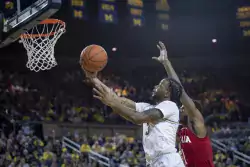
x gave it to them every which way
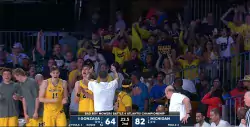
hahahahahahahahahahahahahahahaha

zavier simpson makes everyone else a combo guard
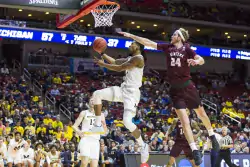
when the opening tip is a neat definition of the game
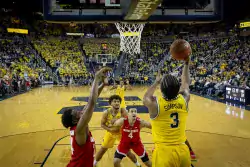
in which Zavier Simpson runs this dusty town in the American West or possibly Mexico

Xavier Simpson recorded a triple-double, and Michigan routed the Buckeyes.
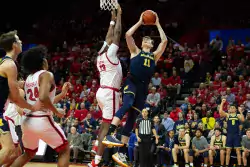
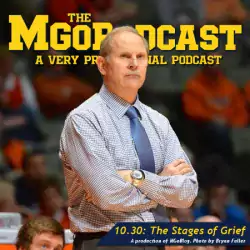
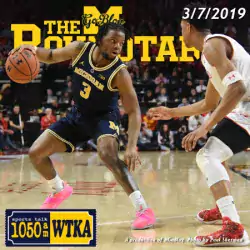
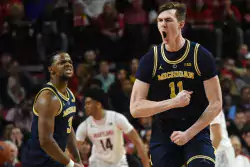
26